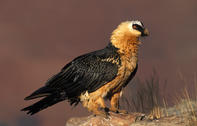
Name
Bearded Vulture (Gypaetus barbatus)Appearance
Bearded vultures weigh in at around 6 kgs, with a wingspan of 2.6 metres. They have “beard” feathers and a distinctive black face mask, they have baggy leggings. The eyes are yellow with a red eye ring. Adults are mostly grey in colour, with orange or rusty red markings. In flight, this vulture is characterised by its long wedge-shaped tail and its long narrow wings. This vulture is not bald headed like many other vulture species.Bearded Vulture Diet
The bearded vulture is a scavenger, eating predominantly bone and bone marrow, which makes up around 85 to 90 % of its diet. It is the only living bird species that specializes in feeding on marrow. Bones that are too large to swallow are carried up to height and dropped onto rocks to break the bones.
The bearded vulture will hunt live prey, specialising in tortoises, with the tortoises being dropped from a height, the same as the bones, to break open the shell. They do the same with other prey, for example, hares and hyraxes.
Bearded Vulture Breeding
The bearded vulture breeding season is from May to June. 1 or 2 eggs are laid in a nest that is around 1 metre wide, built in a pothole or shallow cave on a cliff. The nest becomes larger with each breeding season, up to around 2 metres, with a covering of various animal matter.
The eggs are incubated for approximately 60 days and the hatchlings will spend up to 130 days in the nest before fledging. The young are dependent on the adults for close to 2 years, this leads to the vulture breeding every second year.